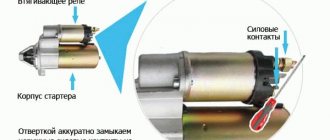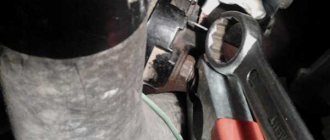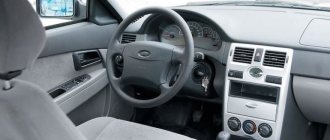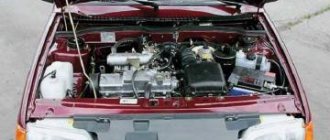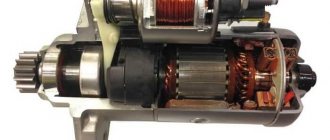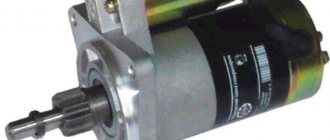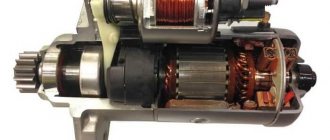Many motorists have encountered a situation where the car refuses to start and the starter is to blame. Most often, when the starter breaks down, it is necessary to continue driving, so motorists are looking for ways that will allow the car to start and drive the distance to the nearest car service center. In domestic and most imported cars, you can easily deal with the problem directly. Knowing how to directly close the starter can quickly but temporarily solve the problem and continue driving.
Often the reason why a car engine fails to start is the starter, so you always need to know how to start the car bypassing this device. Since closing the starter directly is the best option, you need to know all the intricacies of the procedure and perform it carefully and accurately. Using just a few tools, you can start your car in a couple of minutes, which is especially important in cold seasons.
How to close the starter from the pushrod?
Thus, it is possible to start a car engine if the traction relay or the starting device winding is faulty. This method is considered the most common among motorists. In order to start the starter from the pushrod, you will need a couple of assistants who will push the car, resting their hands on the trunk. At this time, the driver engages first gear and turns the key in the ignition. The starter should start the power unit.
Note that the greater the acceleration of the car while pushing, the faster the engine starting device will begin to spin its crankshaft, and the faster the car will start.
The first method or the one that suggests itself
This method is called the old-fashioned method and it involves the help of several strong guys who happen to be nearby. It is enough to rest your hands on the trunk or hood of the car, accelerate it, and at this time the driver will need to have time to start the engine in second gear or in reverse. If the speed of the car is sufficient and the other parts are in order, then the car simply cannot fail to start. This method is popularly called pusher.
Basic starter failures
The starter ensures the engine starts. It creates crankshaft torque at the required speed for the degree of compression and combustion of the combustible mixture. If the starter starts to work intermittently, you need to find out the reason for this behavior.
Important! The starter works with other machine systems in one starting circuit. Therefore, breakdowns can be mechanical and electrical.
If the starter does not want to turn or does it slowly
- pay attention to the electrical circuit and battery:
- The battery is not charged;
- contacts are poorly secured;
- poor contact and broken wire from the solenoid relay terminal;
- damaged wire between battery and starter;
- mismatch of oil in the crankcase in terms of viscosity;
- The ignition switch contact group is not functioning.
If the starter does not work or simply does not turn on,
this could be: a relay malfunction, a short circuit in the winding of the starter itself.
If the starter armature rotates, but the starter cannot crank the crankshaft
this is: slipping of the freewheel or tight running of the screw thread drive.
There are times when the starter does not turn off after starting.
The reasons may be: drives jamming on the armature shaft, jamming in the ignition switch, bearing wear. Such breakdowns can be corrected by replacing damaged parts.
If you notice that the starter has started to make noise.
This could be: the drive gear is out of mesh, the fastening or the starter poles are loose.
We recommend: Why glass encapsulation is needed: advantages of glass in a capsule
The starter is subject to heavy loads, since it has to rotate a large flywheel and drive the engine piston group. Therefore, you should treat it carefully and carry out diagnostics to avoid breakdowns.
Causes
Most often, starter failure is a slow, gradual process. To prevent damage, when the starter slows down, pay attention to the condition of the electrical circuit or battery.
The most common causes of poor starter performance or failure, which is the first thing you should pay attention to if there is a problem:
- Battery.
- Fixing contacts.
- Integrity of wires leading to terminals.
- Damage to the circuit between the battery and starter.
- Not working contact group.
- Winding short circuit, relay failure
- It is also not uncommon for bearings to wear out, but the starter does not turn off after ignition.
If engine operation is accompanied by a strange noise, pay attention to the mountings and drive gear.
Let’s immediately make a reservation about the case when the breakdown can be eliminated only by repairing the starter or starting the car with a push - when you turn it on, there will be a sound of the armature rotating at idle, or the Bendix overrunning clutch slipping, this means that the breakdown of the unit is mechanical. This means failure of the fork, overrunning clutch or planetary gearbox (if such is provided for in the design of the car).
Slow rotation of the flywheel is a sign of armature contact with the stator. In the jargon of motorists - “shoes”. The reason for this is wear of the bushings. With further operation of the starter with obsolete plate bushings, the armature winding clinging to the stator will shift, damaging the winding wires, thereby causing a short circuit.
If there is a problem with the power supply, auto electricians use the method of turning on the starter by shorting the terminals of the “positive” wires connected to the solenoid relay. If such diagnostics do not produce results, then the cause is sought inside the stator.
Scheme, theory and practice
Let's see what the wiring diagram of any electric starter looks like. Contact B is constantly supplied with voltage.
Starter and its external circuits
In the diagram we see three “positive” contacts and one negative (8), which is always connected to the body. What needs to be closed:
- Before closing the starter, locate the S terminal. It is often made in the form of a petal;
- How to distinguish contacts B and M: the first will have a potential of “+12”;
- You need to close contact B with terminal S. This is done briefly and after turning on the “neutral”;
- Contacts M and B cannot be closed.
We move from theory to practice. On a VAZ-2114 car everything looks simple.
Solenoid relay VAZ-2114
Terminal B here is covered with a rubber band, and petal S is in contact with the terminal in plastic. The plastic plug is removed before “shorting”.
Closing the starter contact with a screwdriver
Make sure that the metal of the screwdriver does not touch the relay body when closing. Otherwise, we will simply close the “+” contact to “ground” (dangerous). All work is carried out with the ignition on.
Explanation of symbols:
- B – Bold, “thick” wire;
- M – Motor (electric motor);
- S – Start.
conclusions
Let's look at diagram 1 again. If the key is not turned to the
Start label, terminal S is “hanging in the air.”
This can be done for any car, even if the circuit has an additional relay. This means that it will not be necessary to disconnect the standard wire from terminal S... And in the case of a VAZ, the disconnection is carried out in order to gain access to the terminal.
We removed the filter, disconnected the plug, and tried to close it...
If the engine filter cannot be removed or access is blocked by the battery, we do it differently - we use only the crank.
It is better to close the contacts not with a screwdriver, but with any wrench (see photo). It is desirable that the handle be insulated.
12 Volt voltage is not dangerous, but errors can result in blown fuses. Good luck.
For those who do not understand everything: the filter must be removed from the mounts, but not from the “corrugation”. The filter housing is placed on the battery.
Ways to start a car without interfering with the system
First of all, it is necessary to identify the reason why the starter fails. If the power unit refuses to work due to failure of the solenoid relay or starter winding, then you can try to start the car with a pusher or by towing.
We recommend: Replacing the heater fan of a Chevrolet Niva car with your own hands
VAZ 2114 or VAZ 2110 is easily started using a pusher. The light weight of the car allows you to try to start the car with just a couple of assistants. Resting against the car from behind, they must try to accelerate it, and while driving, the driver turns the key in the ignition and turns on first gear.
The time it takes to start the engine depends on the speed of the car.
If this method does not allow you to obtain the desired result, then you must try to tow the car. This will require the help of other drivers. A special cable is attached to the car, with the help of which towing occurs.
This method is analogous to pushing a car, but its efficiency is much higher.
Many motorists easily agree to help in a difficult situation, so there is no need to be afraid of stopping the car even on major highways.
When starting the engine by towing, it is worth remembering that the car is accelerating and when stopping it is necessary to ensure the safety of the car in front, but the engine cannot be turned off.
Why does the starter refuse to turn?
The most common cause of starter failure is a malfunction of the solenoid relay. This can be determined by the characteristic click that is heard from under the hood after you turn the ignition key. This sound tells you that the relay is engaged and the overrunning clutch is unable to turn the crankshaft due to lack of power.
To summarize the article, we note that now you know how to start the engine when the starter does not turn. We looked at three methods, and one of them will probably work when trying to start the internal combustion engine.
A car starter is a device designed to start an engine by rotating its crankshaft. Its design is based on a conventional electric DC motor, which is controlled by the driver from inside the car.
The starter does not have a permanent connection with the crankshaft of the power unit. They interact for just a few seconds at startup thanks to a special relay. This is what we will talk about in this article using the example of the fourteenth model Samara. We will try to figure out what the VAZ-2114 starter relay is, where this device is located, and how it works. We will also look at its main faults and the procedure for replacing it.
Let's start with the location of the device. On the “fourteenth” it is located on top of the starting device housing. Essentially, these two nodes are combined into one, although they are completely different devices. At the front they are closed by a common cover, under which there is a mechanism connecting them.
Some drivers are inclined to think that on the VAZ-2114 the starter relay is a separate element that serves to protect the electrical circuit of the starting device. In fact, everything is not like that. Indeed, individual car owners, incl. and “fourteenths”, install an additional circuit breaker in the starter circuit. But it has nothing to do with the device we are considering.
For VAZ-2114, the starter relay consists of:
On different modifications of the VAZ-2114, different starter circuit breakers can be installed. Some of them are collapsible, others are not. The former, if they malfunction, can be attempted to be repaired, while the latter can only be replaced.
The starter relay is often called a pull-in relay. This is due to the principle of its operation. As on other cars, on the VAZ-2114 the starter relay performs the function of connecting the starting device to the electrical circuit and connecting its armature to the crankshaft. This happens as follows. When no current is supplied to the windings of the device, its armature, under the action of the return spring, remains in the forward position. The same spring, through a special fork, holds the Bendix gear, preventing it from engaging with the crankshaft flywheel ring.
By turning the key in the ignition, we supply current to the winding of the device. Under the influence of an electromagnetic field, the armature is fed back (pulled into the housing), closing the starter power contacts. The Bendix gear also moves, engaging with the flywheel. At the same moment, the retracting winding is turned off, and the holding winding comes into play. The force from the starter shaft is transmitted through the gear to the flywheel, causing the crankshaft to rotate until we no longer hold the ignition key in the start position.
You can understand that the starter relay on a VAZ-2114 has failed by the following signs:
- when you turn the key in the ignition switch, you cannot hear a characteristic click;
- there is a click, but the starter does not turn;
- When the key is returned to the neutral position, the starter does not turn off.
The retractor may lose its functionality due to:
- violation of wiring integrity;
- breakage (burnout) of windings;
- burning (oxidation) of contacts;
- weakening the return spring.
Before judging that the starter relay is faulty, it must be tested. It is recommended to start with wiring. To check, we need a multimeter turned on in voltmeter mode and an assistant. We connect the positive probe of the device to the positive terminal of the disconnecting device, the negative one to ground. Next, ask the assistant to turn on the ignition and start the starter. We take voltmeter readings. If the device shows a voltage of 12 V or more, everything is in order with the battery and wiring. If it is lower, the battery may be discharged.
Now let’s check the condition of the contact “nickels”. Disconnect the wire coming from the ignition switch from the relay. Using a large screwdriver, we close the terminal of the device connected to the battery and the terminal connecting it to the starter. This way we supply voltage directly to the starter. The starting device worked - the problem is definitely in the relay. All that remains is to decide whether to repair it or replace it.
As already mentioned, relays on the “fourteenths” can be non-separable or collapsible. In the first case, there is nothing to guess - you need to buy a new device. If it is collapsible, you can try to repair it. However, manual repairs can only be justified in the event of burning or oxidation of the contact “nickels”. It is not advisable to rewind the windings yourself or change the internal parts of the device.
How much will it cost to buy a new relay? Believe me, it’s cheaper than repairing it. The cost of a standard domestically produced device is about 700 rubles. You can also buy an imported VAZ-2114 starter solenoid relay. The price of foreign analogues starts from 800 rubles.
When it comes to performing repair work, you will have to choose. If you have enough experience in handling hand tools and a couple of hours of free time, you can easily do it yourself. If you don’t want to bother with this, contact a car service. There, in a maximum of an hour, they will install a new VAZ-2114 starter relay without any problems. The price for such work is about 800 rubles. Expensive? Then roll up your sleeves!
Replacing the VAZ-2114 starter solenoid relay involves using the following tools:
Replacing the VAZ-2114 starter relay is carried out in the following order:
To ensure that the solenoid relay lasts as long as possible, listen to these tips:
- If the battery is discharged, the starter turns slowly and its speed is not enough to start the engine, stop trying to start the car. This will not only cause the battery to become deeply discharged, but also damage the starter relay.
- When starting the engine, do not turn on the starter for more than 15 seconds. This will lead to an overload in its circuit, due to which the relay contacts may burn out, its windings and the starter windings may burn out.
- When choosing a replacement solenoid relay, do not buy cheap products. It is better to give preference to parts from well-known manufacturers, and buy them only in specialized stores.
Hello, dear car enthusiasts! Many of us, motorists, have at least once in our lives found ourselves in a situation where the car starter stubbornly refused to fulfill its intended purpose.
According to the well-known Murphy’s law (in common parlance “the law of the falling sandwich”), such troubles happen at the most inopportune moment - you have to go, and time is running out. In such cases, there is nothing left to do but start the car without a starter or close it directly and hit the road.
Before closing the starter directly, diagnostics are recommended
Before taking decisive action, it would be a good idea to try to identify the causes of starter failure, because some of them can be eliminated on the spot.
The most difficult starter failures include:
- starter relay fault
- Solenoid relay malfunction
- Bendix wear
- burnt out starter winding.
If you have diagnosed one of these complex breakdowns, you can immediately begin to look for a way to start the engine with a non-working starter. These methods are few, but they work flawlessly.
The essence of the first simple and reliable way to start a car without a starter is that several strong, sympathetic neighbors in the garage rest their hands on the trunk of the car and, on command, begin to accelerate.
While you are driving, you turn on the ignition key and first gear. The more active the pushers are (in terms of acceleration speed), the faster the engine will start. This method of starting a car is called “push-start” and is the most popular among car enthusiasts.
The second most popular and effective auto-folk method to “revive” a car engine is towing. It consists in the fact that your car is towed by another car for some distance using a cable.
You need to exercise maximum caution in this case: first, keep in mind that when your car starts, it will definitely begin to accelerate. Secondly, when the car in front of you stops, do not forget to stop your car. Finally, do not turn off the engine when you get out of the car to unhook the cable, otherwise you will have to repeat the entire procedure.
Starting the engine while towing a vehicle
This is another common method for starting a car engine with a faulty starter.
Important! This method is not suitable for vehicles equipped with an automatic transmission, since due to certain features of its design, towing the vehicle is strictly contraindicated.
To implement this method, you will need a tow rope and another car. It is extremely important to strictly follow the following sequence of actions during towing:
- the leading machine should start moving smoothly and start moving at low speed to tension the cable;
- the driver of a towed car should not brake sharply;
- after the vehicle starts, it will begin to accelerate sharply;
- you should stop only after the leading car stops;
- Do not turn off the engine while unhooking the cable, otherwise it may not start, and towing will be required again.
Turning on the starter directly from the battery
ATTENTION! A completely simple way to reduce fuel consumption has been found! Don't believe me? An auto mechanic with 15 years of experience also didn’t believe it until he tried it. And now he saves 35,000 rubles a year on gasoline!
To make a direct contact with your own hands, you just need to get a piece of copper cable, a connector and an alligator clip. These three components are used to solder a device that will run the starter directly from the battery.
More details:
- Under the hood of the car, near the right headlight, there is a red wire with a plug that needs to be disconnected and the prepared cable with a connector inserted into it;
- The car is idled;
- The ignition is turned on;
- The crocodile connects neatly to the positive side of the battery.
These manipulations are often enough to start the starter if it is working and has no other problems. After the car starts, the crocodile needs to be thrown off the plus side.
It is recommended to always keep such a homemade device with a connector and a crocodile in the trunk as a last resort. After using it, it is simply pulled out, and the previously removed plug is put back in place. Everything is easy and simple, except for one thing - you need to work carefully so as not to get burned or short circuit something else.
Close the starter from the pushrod
Before starting the car directly through the starter, you should find out why the starter failed.
If the reason is a malfunction of the relay, solenoid relay, or starter winding, then you can start it from the pusher.
For this you will need a couple of assistants. They will rest against the trunk of the car and accelerate it, and you turn on the ignition key and first gear. The faster the assistants push the car, the faster it will start.
Did you know? Acceleration from a pusher is the most popular method of starting a car without a starter among car enthusiasts.
Diagnostics
It is necessary before the motorist wants to take active action. If you can identify the reasons for this behavior of the starter, then they can be eliminated right on the spot, without even going to a car service center and without wasting extra time. The basics of starter repair teach us that the most complex breakdowns are the following:
- The starter relay has failed;
- The solenoid relay has deteriorated;
- The bendix is worn out;
- The starter winding is burnt out.
If at least one of the above breakdowns is confirmed, you have to look for ways to start a car with a non-working starter. They exist, but they are very few. But they will help you cope with the problem 100 percent.
What to do if there is no key
The method we just looked at is not the only way to start the starter.
There are several more options. The first involves starting the starter from inside the car. To do this, you will need to remove the plastic panel that is located under the steering wheel of the car. The next step is to separate the wiring harness going to the ignition switch.
Find the wire that goes to ground (could be black, green, or yellow with a black stripe). It is possible to determine the required conductor using a tester. Connect one tip to the wire being tested, and the other to the car body. If the display shows zero, then that's what we need.
We recommend: Restoring the panel after airbag deployment
Strip the neutral wire, insulate it and move it to the side. Power to the starter on the VAZ-2114 is supplied through a red or yellow wire. To avoid confusion, check with a tester.
Next you need to determine the conductor that is responsible for the starter. To do this, connect the supply wire with the remaining ones in turn. From which the mechanism will work, we will continue to work.
Connect the remaining bundle to the positive wire, and then close it with the starter terminal. If you have determined everything correctly, the engine should start. Keep in mind that you cannot connect the wires for a long time, so as not to discharge the battery.
As with the first method, the gearbox must be in neutral.
Forced starting of the starter
This method involves shorting the starter contacts, and to implement it you will need the help of another person and a long screwdriver (a wrench will also work).
The idea is to use the metal part of your chosen tool to connect the power contacts of the starter in order to transfer voltage directly to the winding. The sequence of actions should be as follows:
- Ask your assistant to sit behind the wheel of the car so that he turns the key to the extreme right position (including the ignition).
- Remove the contact plate (chip) from the starter.
- Use the tip of the tool to short-circuit the contacts.
Before using this method, check the condition of the transmission.
The slide must be in a neutral position. Make sure that the car is on the parking brake (the handbrake should be raised).
We close the starter “in French” (special cases)
Access to the starter is always open from under the bottom - you just need to remove the crankcase protection. An example is in the photo below.
Under the bottom of Renault Megane 2
It is difficult to reach the starter from the engine compartment. In the best case, it is closed by a filter (VAZ), in the worst case, by a battery. You can remove the filter, but what about the battery?
Starter installation location (circle)
Everything is done so that the starter can be changed, repaired, but not short-circuited.
What does terminal S look like?
On Renault cars, the terminal looks like a threaded outlet. The nut screwed onto it is “white”, although it itself is made of copper (see photo).
Starter Renault Logan, phase 1
We have already talked about the VAZ - they use a plug. If you remove it, you can see the “petal”.
Starter VAZ-2110
The starting method using a screwdriver is not the best. The problem is limited access.
50 Amps
The pull-in relay on the “Ten” consumes 50 Amps. For budget Lada models the current is 30 A, for many foreign cars it is higher. This means that a current of 40-50 Amps will flow from terminal B to terminal S. Think about the dangers of this.
We are going to short-circuit the starter with a screwdriver, but at the connection points where the current will flow, it may “stick”. In this case, without unnecessary panic, remove the negative terminal from the battery.
To remove the minus terminal, you need a 10mm open-end wrench. Keep it with you.
Video about VAZ-2110 starter repair
The purpose of writing this text is to warn car owners against one common mistake. When the key is turned to the START/KRANK mark, the starter does not turn, and then they try to close the power terminals directly. Having opened the hood and reached the starter, they see two copper taps - they are closed. In this case, the electric motor is activated, but the solenoid relay is not activated, and the freewheel bearing remains in place. In reality, power taps cannot be shorted! We will talk further about how to properly close the starter with a screwdriver.
Method two - towing
No less efficient and even more reliable, but you need another machine more powerful than your car. It will be enough to tow the vehicle for a short distance, and then start the engine in the same manner as described above. In this case, I would like to give a couple of practical tips:
- Do not turn off the car after it has started and then go straight to the service center;
- Do not forget that after starting the car, it will pick up speed if it is in second gear and you press the accelerator pedal;
- Don’t forget that after starting, the car towing you will stop. Therefore, you will need to have time to slow down.
Each of the listed options can be used to get to your home or service station. It is highly not recommended to use them every day.
Auto magazine AutoCool
As a rule, a problem such as a breakdown of the starter catches most motorists at the most inopportune moment. And the problem has to be solved quickly, on the spot, using non-standard, but no less effective methods. But when solving the problem, many questions arise - how to connect the starter correctly, how to close the starter directly, how to bridge the starter with a screwdriver, and so on. Let's look at all the intricacies of the various methods. For more correct and prompt repairs, it is necessary to understand the reasons.
